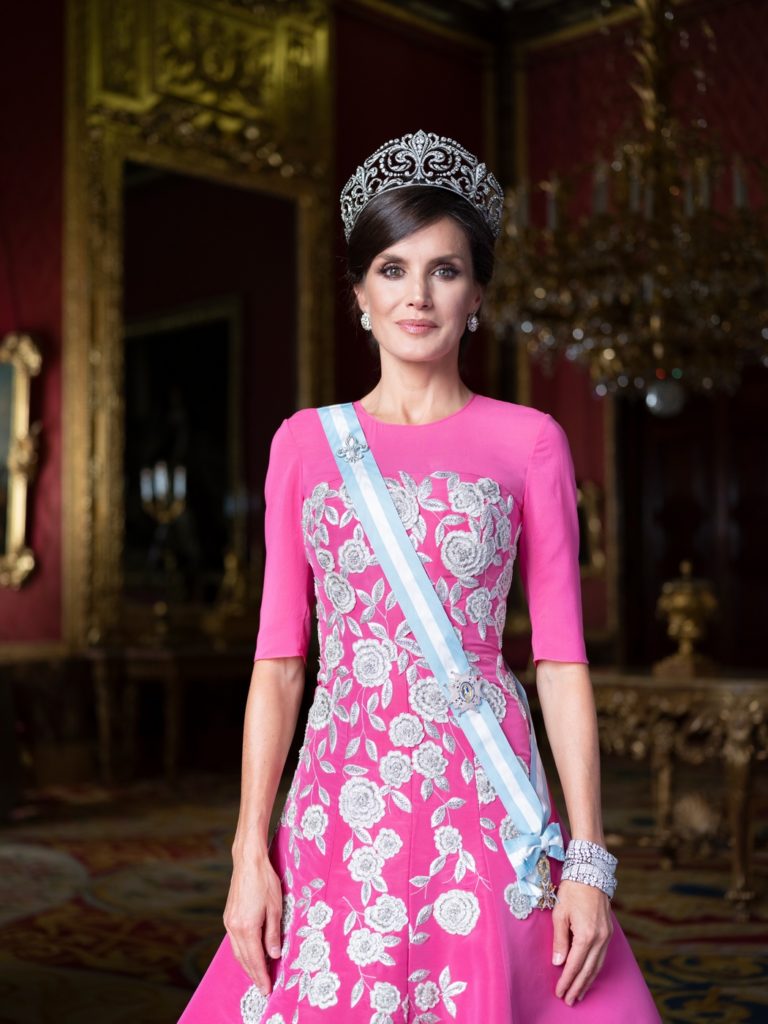It is not uncommon for monarchies to hold priceless pieces of jewellery that enjoy special status: they don’t belong to any specific person, nor can they be sold or separated.
This is also the case for Spain, when Queen Victoria Eugenia, better known as Ena, decided to create a set of jewellery pieces to be passed down from generation to generation of queens.
According to Queen Ena, the pieces should not be sold nor modified, and she herself seems to have taken this rule very seriously; although she altered many jewels in her collection, the pieces she made part of this group were barely touched.
And so, the ‘joyas de pasar’ were born. Literally meaning “jewellery to be passed,” this group of jewels was put together by Queen Ena and was not originally created as a parure.
The collection includes a tiara, three necklaces, a pair of earrings, two bracelets, and two brooches.
The tiara is probably one of the most recognisable pieces. It was created in 1906 by Spanish jeweller Ansorena as a gift from King Alfonso XIII to his new wife, Queen Ena. Ena herself used it as a wedding tiara, although this use has since been dropped, and both Queen Sofía and Queen Letizia have opted to use the Koch Prussian Tiara for their respective weddings.
The tiara is extremely tall, but, contrary to other “big guns” (like the Bragança tiara in Sweden or the Empire tiara in Luxembourg), it looks a lot “airier”; it features a three fleur-de-lys motive, surrounded by diamond scrolls.

The next item is a necklace made of “big diamonds”; its length has been altered various times during the course of the centuries to adapt it to different wearers, but nothing else has been changed; the last person to wear it was Queen Sofía, as Queen Letizia has never worn a huge amount of necklaces.
And so the second necklace hasn’t been seen in more than a decade. The piece is made of 37 big pearls and was yet another wedding gift from King Alfonso XIII to Queen Ena.
The third and last necklace is described as “four strands of big pearls,” and it has been seen several times on Queen Ena, the Countess of Barcelona, and also Queen Sofía.
The earrings were described as “a pair of earrings with a big diamond and diamonds around it,” also known as diamond clusters. They were yet another wedding gift to Queen Ena and were used as wedding earrings again in 1997 when Queen Sofía loaned them to her daughter Cristina for her own ceremony.
As for the brooches, Queen Ena said in her will (which is the document that created the ‘joyas de pasar’) that the first was a diamond brooch with a pendant that is a pearl called “La Peregrina.” However, the pearl is not the real “La Peregrina,” and it has since been known as “La Peregrina II.” Queen Sofía has also used it as a necklace pendant in the past.
The second brooch is a grey pearl surrounded by diamonds, with a pear pearl pendant. Not much is known about the history of this particular piece, but it has been seen in several of Queen Ena’s portraits.
And finally, the other well-known piece of the ‘joyas de pasar’ is two bracelets. They have been a prominent feature on Queen Letizia’s wrist in recent years, not only for big state events but also for moments that are special for her. On the orders of Queen Ena, the bracelets were created by jeweller Bvlgari starting from a coronet/bandeau created by Cartier as an engagement gift from King Alfonso in 1906 – hence why they are referred to as being made by Cartier.
The ‘joyas de pasar,’ then, were put together by Queen Victoria Eugenia, who pulled them mostly from her wedding and engagement presents. In her will, she specifically stated that the jewels were to be passed down from Queen to Queen. She seemed to have great trust in the restoration of the monarchy as anticipated by Generalísimo Franco, as she was the last Queen Consort – her husband was deposed in the 1931 coup.
Despite never being Queen, the Countess of Barcelona (wife of King Alfonso XIII’s son) wore several pieces of the ‘joyas de pasar’ before her husband formally renounced his claims to the throne in 1977, and his own son, Juan Carlos, was proclaimed King. Since then, Queen Sofía has worn several pieces from the set, and now they have made several appearances on Queen Letizia.
Their real moment to shine, however, will be when Leonor becomes Queen, as she will be the first Queen Regnant ever to make use of the jewels; so far, they have only graced the figures of Queen Consorts.

